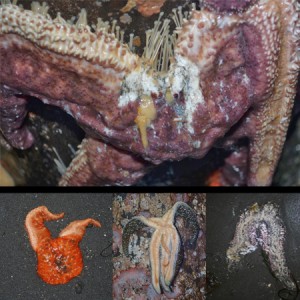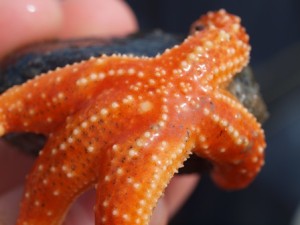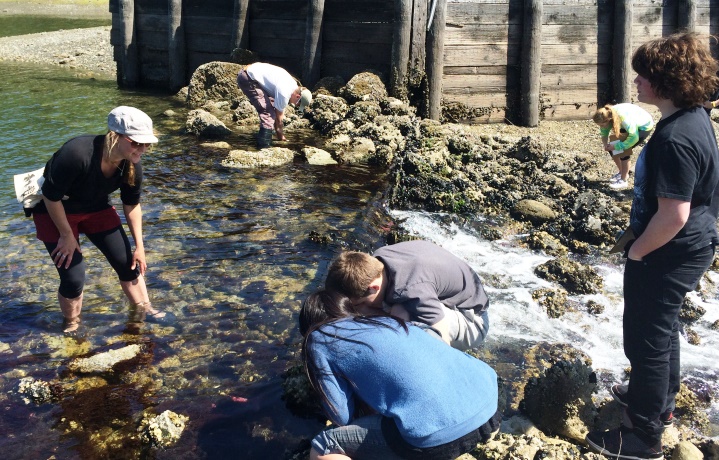Above: VHS students help Vashon Nature Center scientists Bianca Perla and Jeff Adams survey Raab’s lagoon for sea stars last spring. For results see end of article.
by: Adria Magrath
A few years ago, a devastating disease swept through areas of the west coast, turning those afflicted into a disembodied mess in a matter of days. First, white lesions form and arms twist off- sometimes crawling away- and then bodies dissolve. It’s an ugly sight and many in our community are concerned about this disease; some even work to monitor it on our island beaches. You’ve likely heard about it by now; it has turned the once abundant sea stars into a rare sight. Called Sea Star Wasting Syndrome, or SSWS, it began to impact the country in a substantive way two years ago. While scientists seem to have identified a culprit and our understanding of the disease has grown, the situation hasn’t necessarily gotten any less dire for the sea stars. In 2013, when the Vashon Beachcomber first published an article I wrote on the epidemic, it had only impacted certain regions of Washington, British Columbia, and central California. But by the summer of 2014, SSWS had spread and spared no part of the West coast. From Alaska to Mexico sea stars melted away at alarming rates. Reports indicate that up to 90% of the population has been lost in some areas. Even aquariums are battling the disease; only facilities that UV sterilize their incoming sea water have been able to maintain healthy populations. At least 20 different species are affected, but the heaviest hit include the sunflower star (Pycnopodia helianthiodes), ochre/purple star (Pisaster ochraceus), and pink star (Pisaster brevispinus)- all species previously common on Vashon’s shores.

Sea stars in various stages of the wasting syndrome, North end ferry dock. photos by: Kelly Keenan
According to a paper recently published by a consortium of scientists, the pathogen responsible is the family of parvoviruses, and is called Sea Star associated Densovirus (SSaDV). Researchers tracked down this particular virus by sampling 335 sea stars from sites spanning the west coast and studying the genetics of the infectious particles. Perhaps surprisingly, this densovirus is neither new nor rare, but is rather ubiquitous in the marine environment. It was detected in tube feet samples from museum specimens of sea stars dating back to 1942 and scientists found it in the majority of marine sediments and plankton samples they tested, as well as other echinoderms (the phylum containing sea stars, which also includes sea urchins, sand dollars and sea cucumbers).
If this disease-causing virus has been around for at least 74 years, then what has changed to cause the current severe outbreak? Scientists at Cornell are searching for clues in the genetics of the virus to figure out what has changed to make it more virulent recently. Clues lie in other parvoviruses’ ability to become more infectious when genes coding for the protein shell change.
It is also highly likely that the ultimate culprit may not be a single player but a combination or even synergy of factors. University of Texas at Arlington researchers who were a part of the Densovirus study are further researching whether environmental factors and water pollution can cause an increased susceptibility to the virus. To those who care for them in captivity, sea stars are notoriously sensitive to changes in environmental factors such as salinity and temperature. Some experts think alterations in sea water chemistry (such as dissolved gases) may turn out to be an important factor weakening the creatures’ immune systems and contributing to this serious outbreak.
Some of these same UT Arlington scientists spent a recent summer at Friday Harbor’s UW laboratories researching the ‘host response’ to the virus, ultimately finding gene expression changes in inflammatory and immune pathways, an expected response to a viral infection, but also changes important for collagen maintenance and certain nervous system processes. This work may begin to offer the first clues to the melting symptoms, tissue decay and contorted arms that fall off and crawl away.
Yet despite all this new knowledge about the disease, the outlook for sea stars still remains unclear. Last year, there were signs indicating the outbreak was waning. Multi-Agency Rocky Intertidal Network (MARINe) surveys at field sites up and down the west coast were seeing population rebounds in the form of juvenile sea stars. According to one of the lead researchers, 2014 saw the highest numbers of baby sea stars since records have been kept. Places like Fogarty Creek in Oregon and near the Redwoods and Bodega Bay in California, were showing strong signs of recovery. Jeff Adams, a Vashon resident and marine ecologist with Washington Sea Grant in the UW College of the Environment, coordinates the Kitsap and Vashon sea star surveys. His team was excited to see baby sea stars last summer at their survey site on the North-end ferry pilings. Most recently however, successive waves of the disease have been seen sweeping through, and informal reports indicate that there are again steep number losses. Even Jeff Adams’ surveys came up empty the last time he was able to access the site; right before the retrofitting work began. However, he also stresses that due to the fact that these surveys are restricted to intertidal zones, population changes don’t necessarily mean mortalities, and the sea stars could have just moved to deeper waters.

A baby ochre sea star found in the 2012 VNC Bioblitz at Neill Point. Younger stars tend to fend off the disease slightly better than older ones. photo credit: Nathan Enzian
For now, MARINe has begun to focus on the broader ecological consequences of SSWD. Because scientists view the sea star as a keystone species in its community’s hierarchy, their worry is for a collapse of intertidal and subtidal ecosystems and an overabundance of prey species. Long-respected research shows that once sea stars are removed, monocultures of prey species tend to replace biodiverse systems. Field observations seem to be bearing this out; mussel and sea urchin populations are now booming in certain places near central California. And because a big herd of sea urchins can quite handily mow down the nearby protected kelp forests, marine ecologists are now afraid of wider-ranging ecological effects. But the outlook isn’t all that rosy for the urchins either, as they are now beginning to succumb to the disease in areas of Southern California.
Researchers’ spirits are buoyed however by an observed decrease in the disease prevalence during much of the past year. Even though incidence of the disease is now down, populations are much, much smaller. By most expert accounts, sea star populations had become too numerous and dense, and we can hope that this smaller, more reduced population represents individuals better able to handle the viral load. The replenishment of sea star communities by juveniles definitively shows that at least some adults are escaping the disease and successfully releasing thousands of larvae. This gives hope to those who know. Only time will tell if sea stars are capable of adapting quickly enough to adjust to and persevere in the altered conditions in which they find themselves- whether viral or environmental too.
Editor’s additions: Vashon High School 10th graders will be working with scientists at Vashon Nature Center to monitor 5 Vashon beaches for seastars this spring 2016 as part of Vashon Nature Center’s Scientists in Schools program. These sites were monitored by students in 2014 and 2015.
A student team poster summarizing results of the 2015 monitoring at Raab’s lagoon
The results of this year’s student monitoring, along with other island specific wildlife research topics, will be presented at the spring Ed Talks symposium. Ed Talks will be held at Open Space on May 15th 2:00-5:30 pm. Join us this year to hear all about Nature on the Rock!
More Reading:
Breaking news on water temperature influence
http://www.uta.edu/news/releases/2015/07/fuess-sea-stars.php
http://www.pnas.org/content/111/48/17278.full
http://www.pbs.org/newshour/rundown/scientists-solve-mystery-of-west-coast-starfish-deaths/

